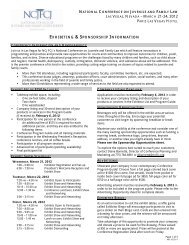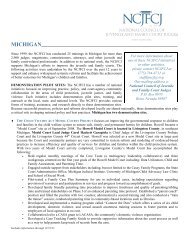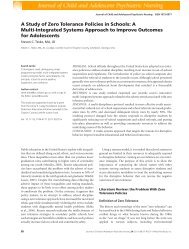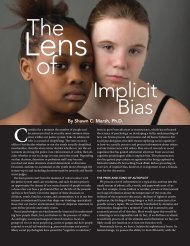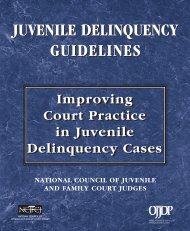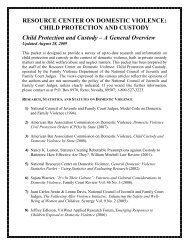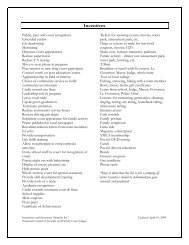The Marijuana Detection Window - National Drug Court Institute
The Marijuana Detection Window - National Drug Court Institute
The Marijuana Detection Window - National Drug Court Institute
- No tags were found...
You also want an ePaper? Increase the reach of your titles
YUMPU automatically turns print PDFs into web optimized ePapers that Google loves.
DRUG COURT PRACTITIONER FACT SHEETTo one degree or another, answering thesequestions depends upon the ability of the courtto estimate the length of time cannabinoidswill likely remain detectable in urine followingthe use of marijuana by a drug court client.Thus, the cannabinoid detection windowbecomes a determinative factor in the appropriateinterpretation of urine drug testingresults for marijuana. <strong>The</strong> lack of adequateguidance has hindered the development ofthese standards for use in drug court.It is important to note that while courtsmay be seeking absolute answers (an exactcannabinoid detection window), the scienceof drug detection in urine can only providereasonable best estimates. <strong>The</strong> law is notalways black and white; neither is science.<strong>The</strong>refore, precise “yes/no” answers orexact detection windows are generally notattainable. Sensible guidance for the interpretationof urine cannabinoid results by drugcourts, however, is achievable.FRAMING THE QUESTIONSimply put, the detection window is the lengthof time in days following the last substanceusage that sequentially collected urine sampleswill continue to produce positive drug testresults—in other words, the number of daysuntil last positive sample. This time period isnot the same as the length of time a drug willremain in someone’s system—that conceptis, in reality, indeterminable (given that thereis no analytical method capable of detectingthe presence of a single molecule of drug in adonor’s body). <strong>The</strong> question being addressedherein is not how long minute traces of marijuanawill remain in a client’s tissues or fluidsafter smoking, but rather how long thoseresidual cannabinoid metabolites will continueto be excreted in urine in sufficient quantitiesto produce a positive drug test (by standardscreening and confirmation testing).Study subjects with exceptionally longcannabinoid detection times (30-plusdays) were just that-exceptional.For those compounds with uncomplicatedmetabolic pathways or for those drugs thatare not significantly retained in body storagecompartments, detection times have beenestablished and generally accepted. <strong>The</strong>seinclude urinary detection windows for drugssuch as cocaine (1-3 days), amphetaminesand opiates (1-4 days), and PCP (1-6 days)(Baselt, 2004). For marijuana, the urine eliminationprofile used to establish the detectionwindow is more complex. It is well documentedand understood that cannabinoids arelipid-soluble compounds that preferentiallybind to fat-containing structures within thehuman body (Baselt, 2004). This and otherchemical characteristics can prolong the eliminationhalf-life of cannabinoids and extend thedetection window beyond that of other abusedsubstances. Chronic marijuana use, whichexpands body stores of drug metabolitesfaster than they can be eliminated, furtherincreases cannabinoid detection time in urine.VARIABLESEstimating the detection time of a drug in urineis a complex task because of the many factorsthat influence a compound’s elimination fromthe body. Additionally, technical aspects of thetesting methods themselves also affect howlong a drug will continue to be detected in urine.<strong>The</strong> pharmacological variables affecting theduration of detection include drug dose, routeof administration, duration of use (acute orchronic), and rate of metabolism. <strong>Detection</strong>time is also dependent upon analytical factorsincluding the sensitivity of the test (cutoffconcentration) and the method’s specificity(the actual drug and/or metabolite that isbeing detected).3




